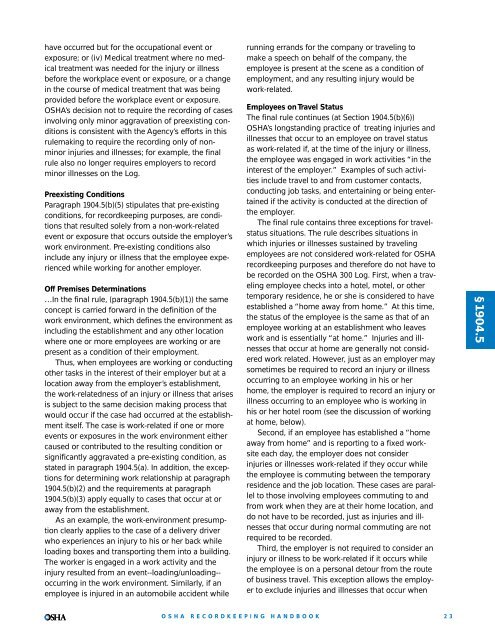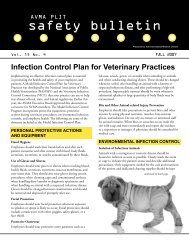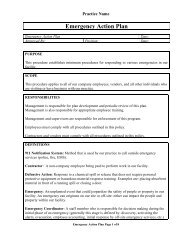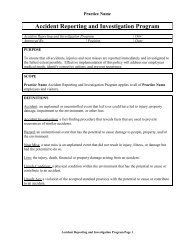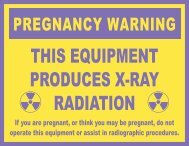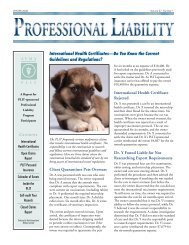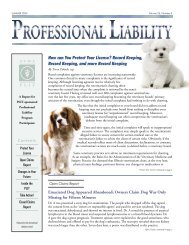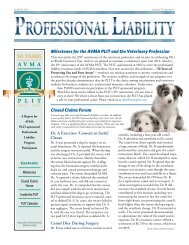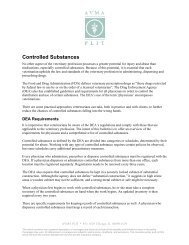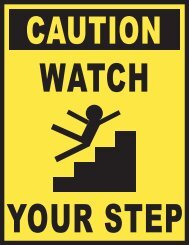§1904.5pain and swelling in a joint but cannot say whetherthe symptoms first arose during work or duringrecreational activities at home, it may be difficult forthe employer to decide whether the case is workrelated.The same problem arises when an employeereports symptoms of a contagious disease thataffects the public at large, such as a staphylococcusinfection (“staph” infection) or Lyme disease, and theworkplace is only one possible source of the infection.In these situations, the employer must examinethe employee’s work duties and environment todetermine whether it is more likely than not that oneor more events or exposures at work caused or contributedto the condition. If the employer determinesthat it is unlikely that the precipitating event or exposureoccurred in the work environment, the employerwould not record the case. In the staph infectionexample given above, the employer would considerthe case work-related, for example, if anotheremployee with whom the newly infected employeehad contact at work had been out with a staph infection.In the Lyme disease example, the employerwould determine the case to be work-related if, forexample, the employee was a groundskeeper withregular exposure to outdoor conditions likely toresult in contact with deer ticks.In applying paragraph 1904.5(b)(3), the questionemployers must answer is whether the precipitatingevent or exposure occurred in the work environment.If an event, such as a fall, an awkward motion or lift,an assault, or an instance of horseplay, occurs atwork, the geographic presumption applies and thecase is work-related unless it otherwise falls withinan exception. Thus, if an employee trips while walkingacross a level factory floor, the resulting injury isconsidered work-related under the geographic presumptionbecause the precipitating event -- the trippingaccident -- occurred in the workplace. The caseis work-related even if the employer cannot determinewhy the employee tripped, or whether any particularworkplace hazard caused the accident tooccur. However, if the employee reports an injury atwork but cannot say whether it resulted from anevent that occurred at work or at home, as in theexample of the swollen joint, the employer mightdetermine that the case is not work-related becausethe employee’s work duties were unlikely to havecaused, contributed to, or significantly aggravatedsuch an injury.Significant Workplace Aggravation of aPre-existing ConditionIn paragraph 1904.5(b)(4), the final rule...requires thatthe amount of aggravation of the injury or illness thatwork contributes must be “significant,” i.e., nonminor,before work-relatedness is established. Thepreexisting injury or illness must be one causedentirely by non-occupational factors….…As discussed above, <strong>OSHA</strong> agrees that nonwork-relatedinjuries and illnesses should not berecorded on the <strong>OSHA</strong> Log. To ensure that non-workrelatedcases are not entered on the Log, paragraph1904.5(b)(2)(ii) requires employers to consider asnon-work-related any injury or illness that “involvessigns or symptoms that surface at work but resultsolely from a non-work-related event or exposurethat occurs outside the work environment.”The Agency also believes that preexisting injuryor illness cases that have been aggravated by eventsor exposures in the work environment representcases that should be recorded on the Log, becausework has clearly worsened the injury or illness.<strong>OSHA</strong> is concerned, however, that there are somecases where work-related aggravation affects the preexistingcase only in a minor way, i.e., in a way thatdoes not appreciably worsen the preexisting condition,alter its nature, change the extent of the medicaltreatment, trigger lost time, or require job transfer.Accordingly, the final rule requires that workplaceevents or exposures must “significantly” aggravate apre-existing injury or illness case before the case ispresumed to be work-related. Paragraph 1904.5(a)states that an injury or illness is considered workrelatedif “an event or exposure in the work environmenteither caused or contributed to the resultingcondition or significantly aggravated a pre-existinginjury or illness.”Paragraph 1904.5(b)(4) of the final rule definesaggravation as significant if the contribution of theaggravation at work is such that it results in tangibleconsequences that go beyond those that the workerwould have experienced as a result of the preexistinginjury or illness alone, absent the aggravating effectsof the workplace. Under the final rule, a preexistinginjury or illness will be considered to have been significantlyaggravated, for the purposes of <strong>OSHA</strong>injury and illness recordkeeping, when an event orexposure in the work environment results in: (i)Death, providing that the preexisting injury or illnesswould likely not have resulted in death but for theoccupational event or exposure; (ii) Loss of consciousness,providing that the preexisting injury orillness would likely not have resulted in loss of consciousnessbut for the occupational event or exposure;(iii) A day or days away from work or of restrictedwork, or a job transfer that otherwise would not22<strong>OSHA</strong> RECORDKEEPINGHANDBOOK
have occurred but for the occupational event orexposure; or (iv) Medical treatment where no medicaltreatment was needed for the injury or illnessbefore the workplace event or exposure, or a changein the course of medical treatment that was beingprovided before the workplace event or exposure.<strong>OSHA</strong>’s decision not to require the recording of casesinvolving only minor aggravation of preexisting conditionsis consistent with the Agency’s efforts in thisrulemaking to require the recording only of nonminorinjuries and illnesses; for example, the finalrule also no longer requires employers to recordminor illnesses on the Log.Preexisting ConditionsParagraph 1904.5(b)(5) stipulates that pre-existingconditions, for recordkeeping purposes, are conditionsthat resulted solely from a non-work-relatedevent or exposure that occurs outside the employer’swork environment. Pre-existing conditions alsoinclude any injury or illness that the employee experiencedwhile working for another employer.Off Premises Determinations…In the final rule, (paragraph 1904.5(b)(1)) the sameconcept is carried forward in the definition of thework environment, which defines the environment asincluding the establishment and any other locationwhere one or more employees are working or arepresent as a condition of their employment.Thus, when employees are working or conductingother tasks in the interest of their employer but at alocation away from the employer’s establishment,the work-relatedness of an injury or illness that arisesis subject to the same decision making process thatwould occur if the case had occurred at the establishmentitself. The case is work-related if one or moreevents or exposures in the work environment eithercaused or contributed to the resulting condition orsignificantly aggravated a pre-existing condition, asstated in paragraph 1904.5(a). In addition, the exceptionsfor determining work relationship at paragraph1904.5(b)(2) and the requirements at paragraph1904.5(b)(3) apply equally to cases that occur at oraway from the establishment.As an example, the work-environment presumptionclearly applies to the case of a delivery driverwho experiences an injury to his or her back whileloading boxes and transporting them into a building.The worker is engaged in a work activity and theinjury resulted from an event--loading/unloading--occurring in the work environment. Similarly, if anemployee is injured in an automobile accident whilerunning errands for the company or traveling tomake a speech on behalf of the company, theemployee is present at the scene as a condition ofemployment, and any resulting injury would bework-related.Employees on Travel StatusThe final rule continues (at Section 1904.5(b)(6))<strong>OSHA</strong>’s longstanding practice of treating injuries andillnesses that occur to an employee on travel statusas work-related if, at the time of the injury or illness,the employee was engaged in work activities “in theinterest of the employer.” Examples of such activitiesinclude travel to and from customer contacts,conducting job tasks, and entertaining or being entertainedif the activity is conducted at the direction ofthe employer.The final rule contains three exceptions for travelstatussituations. The rule describes situations inwhich injuries or illnesses sustained by travelingemployees are not considered work-related for <strong>OSHA</strong>recordkeeping purposes and therefore do not have tobe recorded on the <strong>OSHA</strong> 300 Log. First, when a travelingemployee checks into a hotel, motel, or othertemporary residence, he or she is considered to haveestablished a “home away from home.” At this time,the status of the employee is the same as that of anemployee working at an establishment who leaveswork and is essentially “at home.” Injuries and illnessesthat occur at home are generally not consideredwork related. However, just as an employer maysometimes be required to record an injury or illnessoccurring to an employee working in his or herhome, the employer is required to record an injury orillness occurring to an employee who is working inhis or her hotel room (see the discussion of workingat home, below).Second, if an employee has established a “homeaway from home” and is reporting to a fixed worksiteeach day, the employer does not considerinjuries or illnesses work-related if they occur whilethe employee is commuting between the temporaryresidence and the job location. These cases are parallelto those involving employees commuting to andfrom work when they are at their home location, anddo not have to be recorded, just as injuries and illnessesthat occur during normal commuting are notrequired to be recorded.Third, the employer is not required to consider aninjury or illness to be work-related if it occurs whilethe employee is on a personal detour from the routeof business travel. This exception allows the employerto exclude injuries and illnesses that occur when§1904.5<strong>OSHA</strong> RECORDKEEPINGHANDBOOK23
- Page 1 and 2: www.osha.govOSHARecordkeepingHandbo
- Page 3 and 4: OSHARecordkeeping HandbookThe Regul
- Page 5 and 6: ContentsRecordkeeping HandbookRoadm
- Page 7 and 8: Section 1904.40Providing records to
- Page 10 and 11: §1904.0…OSHA has rejected the su
- Page 12 and 13: §1904.1Since publication of the re
- Page 14 and 15: §1904.2SIC code Industry descripti
- Page 16 and 17: §1904.2tinue to have injury and il
- Page 18 and 19: Section 1904.3Keeping records for m
- Page 20 and 21: PREAMBLE DISCUSSION: Section 1904.4
- Page 22 and 23: (viii)(ix)The illness is the common
- Page 24 and 25: §1904.5employment environment. For
- Page 26 and 27: §1904.5the employee’s status as
- Page 28 and 29: §1904.5Exceptions Proposed but Not
- Page 32 and 33: §1904.5the worker has taken a side
- Page 34 and 35: §1904.526“Personal tasks” for
- Page 36 and 37: If the accident had occurred in a l
- Page 38 and 39: Scenario 4:• An employee reports
- Page 40 and 41: In applying [the presumption of wor
- Page 42 and 43: Letters of interpretation related t
- Page 44 and 45: November 19, 2002Joseph Woodward, E
- Page 46 and 47: Letter of interpretation related to
- Page 48 and 49: §1904.6that the two injuries or il
- Page 50 and 51: §1904.6…Under the OSHA recordkee
- Page 52 and 53: FREQUENTLY ASKED QUESTIONS: Section
- Page 54 and 55: Since the employee was not performi
- Page 56 and 57: In each of the eight scenarios in y
- Page 58 and 59: §1904.7other licensed health care
- Page 60 and 61: §1904.7that eliminates the routine
- Page 62 and 63: §1904.7pose. This paragraph also s
- Page 64 and 65: §1904.7Counting Lost Workdays When
- Page 66 and 67: §1904.7tors to such injuries and i
- Page 68 and 69: §1904.7This list of first aid trea
- Page 70 and 71: §1904.7visit to a health care prof
- Page 72 and 73: §1904.7However, as discussed above
- Page 74 and 75: §1904.766immediate recording of si
- Page 76 and 77: §1904.7strength? How is an employe
- Page 78 and 79: §1904.7or illness. The severity of
- Page 80 and 81:
The first treatment is glue used to
- Page 82 and 83:
Response: The employer would have t
- Page 84 and 85:
Letter of interpretation related to
- Page 86 and 87:
Letter of interpretation related to
- Page 88 and 89:
§1904.8exposure” as these terms
- Page 90 and 91:
ing blood and other potentially inf
- Page 92 and 93:
standard. In some cases employers v
- Page 94 and 95:
PART 1904—[AMENDED] (67 FR 77170,
- Page 96 and 97:
§1904.1088OSHA RECORDKEEPINGcorrec
- Page 98 and 99:
§1904.1090OSHA RECORDKEEPINGAwaren
- Page 100 and 101:
§1904.1092reasonable checks agains
- Page 102 and 103:
§1904.1094determination. Second, t
- Page 104 and 105:
FREQUENTLY ASKED QUESTIONS: Section
- Page 106 and 107:
Also, from time to time we update o
- Page 108 and 109:
§1904.11Section 1904.11Recording c
- Page 110 and 111:
§1904.11of causation applies to th
- Page 112 and 113:
§1904.12Thus, the total MSD count
- Page 114 and 115:
§1904.12current survey was designe
- Page 116 and 117:
§1904.29son’s blood or other pot
- Page 118 and 119:
§1904.29cern cases, and the list m
- Page 120 and 121:
§1904.29have also been designed to
- Page 122 and 123:
§1904.29with that entry and employ
- Page 124 and 125:
FREQUENTLY ASKED QUESTIONS: Section
- Page 126 and 127:
Section 1904.29(b)(10). In addition
- Page 128 and 129:
Section 1904.30Multiple business es
- Page 130 and 131:
fest themselves quickly and can be
- Page 132 and 133:
§1904.31The term “employee” me
- Page 134 and 135:
§1904.31companies, and other tempo
- Page 136 and 137:
Letter of interpretation related to
- Page 138 and 139:
Scenario 5:• An employee drives i
- Page 140 and 141:
Response: The log is to be kept for
- Page 142 and 143:
Section 1904.32Annual summary(66 FR
- Page 144 and 145:
§1904.32The company executive cert
- Page 146 and 147:
Deletions from the former rule....F
- Page 148 and 149:
I do want to make one further point
- Page 150 and 151:
sede any longer retention periods s
- Page 152 and 153:
Response: The controlling employer
- Page 154 and 155:
Section 1904.35Employee involvement
- Page 156 and 157:
§1904.351904 regulation to provide
- Page 158 and 159:
§1904.35tions on employees’ and
- Page 160 and 161:
employee, the employer must provide
- Page 162 and 163:
Thank you for your interest in occu
- Page 164 and 165:
Letter of interpretation related to
- Page 166 and 167:
Section 1904.36Prohibition against
- Page 168 and 169:
and section 1952.4 spells out the r
- Page 170 and 171:
§1904.38Section 1904.38Variances f
- Page 172 and 173:
§1904.38cited and the citation is
- Page 174 and 175:
§1904.39PREAMBLE DISCUSSION: Secti
- Page 176 and 177:
§1904.39FREQUENTLY ASKED QUESTIONS
- Page 178 and 179:
§1904.40maintains the records at a
- Page 180 and 181:
June 23, 2003Mr. Edwin G. Foulke, J
- Page 182 and 183:
Section 1904.41Annual OSHA injury a
- Page 184 and 185:
Section 1904.42Requests from the Bu
- Page 186 and 187:
Section 1904.43Summary and posting
- Page 188 and 189:
Section 1904.44Retention and updati
- Page 190 and 191:
Section 1904.45OMB control numbers
- Page 192 and 193:
allows him or her to independently
- Page 194 and 195:
§1904.46the three criteria above,
- Page 196 and 197:
§1904.46approach will provide an i
- Page 198 and 199:
FREQUENTLY ASKED QUESTIONS: Section
- Page 200 and 201:
Section 1952.4Injury and illness re


